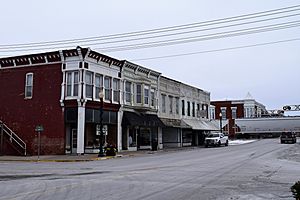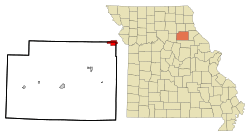Monroe City, Missouri facts for kids
Quick facts for kids
Monroe City, Missouri
|
|
|---|---|

Downtown Monroe City
|
|
| Nickname(s):
Winners Lane
|
|

Location in Monroe County and the state of Missouri
|
|
| Country | United States |
| State | Missouri |
| Counties | Monroe, Marion, Ralls |
| Area | |
| • Total | 3.06 sq mi (7.93 km2) |
| • Land | 3.02 sq mi (7.82 km2) |
| • Water | 0.04 sq mi (0.11 km2) |
| Elevation | 738 ft (225 m) |
| Population
(2020)
|
|
| • Total | 2,652 |
| • Density | 878.44/sq mi (339.12/km2) |
| Time zone | UTC-6 (Central (CST)) |
| • Summer (DST) | UTC-5 (CDT) |
| ZIP code |
63456
|
| Area code(s) | 573 |
| FIPS code | 29-49394 |
| GNIS feature ID | 2395376 |
Monroe City is a town located in Missouri, United States. It is special because it sits across three different counties: Marion, Monroe, and Ralls. In 2020, about 2,652 people lived there. The parts of Monroe City in Marion and Ralls counties are also considered part of the larger Hannibal area.
Contents
History of Monroe City
Monroe City was officially planned and started in 1857. It got its name from Monroe County, where it is located. The town has had a post office serving its residents since 1860.
In 1907, Monroe City removed a rule that had been put in place just three weeks earlier. This rule required Black people to return home by eight o'clock at night. While the rule was active, some people who tried to challenge it faced harsh treatment.
Several important buildings in Monroe City are listed on the National Register of Historic Places. These include the Farmers and Merchants Bank Building, St. Jude's Episcopal Church, and Washington School. These places are recognized for their historical importance.
Geography and Location
Monroe City is found in the northeast part of Monroe County. A small part of the city extends north into Marion County, and an even smaller part reaches east into Ralls County.
Two major U.S. highways, Route 24 and Route 36, meet and split in Monroe City.
- US 36 goes west-northwest about 42 miles to Macon.
- US 24 goes west-southwest about 46 miles to Moberly.
- Both highways together lead east about 22 miles to Hannibal, which is located on the Mississippi River.
US 24 runs through the center of Monroe City as Main Street and 5th Street. US 36 runs along the northern edge of the city.
The U.S. Census Bureau states that Monroe City covers a total area of 3.06 square miles. Most of this area, 3.02 square miles, is land. Only a small part, 0.04 square miles, is water. The city's water drains north into Sharpsburg Branch. This branch then flows into the South Fork of the North River, which eventually reaches the Mississippi River.
You can find two small areas of very old prairie land within 40 miles of Monroe City. These prairies are about 8,000 years old.
Climate in Monroe City
Monroe City has a humid subtropical climate. This means it has hot, humid summers and mild winters. On climate maps, this type of climate is shown as "Cfa".
The hottest temperature ever recorded in Monroe City was 108°F (42°C) on July 30, 1980. The coldest temperature ever recorded was -28°F (-33°C) on February 13, 1905.
| Climate data for Monroe City, Missouri, 1991–2020 normals, extremes 1901–present | |||||||||||||
|---|---|---|---|---|---|---|---|---|---|---|---|---|---|
| Month | Jan | Feb | Mar | Apr | May | Jun | Jul | Aug | Sep | Oct | Nov | Dec | Year |
| Record high °F (°C) | 74 (23) |
81 (27) |
89 (32) |
92 (33) |
94 (34) |
103 (39) |
108 (42) |
106 (41) |
102 (39) |
94 (34) |
81 (27) |
74 (23) |
108 (42) |
| Mean maximum °F (°C) | 59.2 (15.1) |
62.1 (16.7) |
75.4 (24.1) |
84.5 (29.2) |
88.9 (31.6) |
94.8 (34.9) |
97.4 (36.3) |
96.7 (35.9) |
92.5 (33.6) |
85.6 (29.8) |
73.1 (22.8) |
62.3 (16.8) |
97.4 (36.3) |
| Mean daily maximum °F (°C) | 36.0 (2.2) |
39.9 (4.4) |
52.0 (11.1) |
63.9 (17.7) |
73.1 (22.8) |
82.5 (28.1) |
86.2 (30.1) |
85.0 (29.4) |
78.9 (26.1) |
66.7 (19.3) |
52.7 (11.5) |
40.7 (4.8) |
63.1 (17.3) |
| Daily mean °F (°C) | 26.8 (−2.9) |
30.6 (−0.8) |
41.8 (5.4) |
52.9 (11.6) |
63.4 (17.4) |
72.7 (22.6) |
76.2 (24.6) |
74.3 (23.5) |
66.9 (19.4) |
55.4 (13.0) |
42.5 (5.8) |
32.0 (0.0) |
53.0 (11.6) |
| Mean daily minimum °F (°C) | 17.6 (−8.0) |
21.2 (−6.0) |
31.5 (−0.3) |
41.9 (5.5) |
53.6 (12.0) |
62.8 (17.1) |
66.2 (19.0) |
63.6 (17.6) |
54.8 (12.7) |
44.0 (6.7) |
32.2 (0.1) |
23.2 (−4.9) |
42.7 (6.0) |
| Mean minimum °F (°C) | −7.0 (−21.7) |
−3.7 (−19.8) |
12.8 (−10.7) |
26.2 (−3.2) |
38.1 (3.4) |
49.7 (9.8) |
55.0 (12.8) |
51.7 (10.9) |
40.3 (4.6) |
27.9 (−2.3) |
15.2 (−9.3) |
1.1 (−17.2) |
−11.0 (−23.9) |
| Record low °F (°C) | −21 (−29) |
−28 (−33) |
−10 (−23) |
16 (−9) |
27 (−3) |
39 (4) |
47 (8) |
41 (5) |
33 (1) |
18 (−8) |
−7 (−22) |
−20 (−29) |
−28 (−33) |
| Average precipitation inches (mm) | 1.82 (46) |
2.01 (51) |
2.92 (74) |
4.28 (109) |
5.04 (128) |
5.36 (136) |
4.58 (116) |
3.77 (96) |
3.92 (100) |
3.30 (84) |
2.65 (67) |
2.04 (52) |
41.69 (1,059) |
| Average snowfall inches (cm) | 5.4 (14) |
5.5 (14) |
4.3 (11) |
0.7 (1.8) |
0.0 (0.0) |
0.0 (0.0) |
0.0 (0.0) |
0.0 (0.0) |
0.0 (0.0) |
0.0 (0.0) |
1.4 (3.6) |
3.9 (9.9) |
21.2 (54.3) |
| Average extreme snow depth inches (cm) | 2.9 (7.4) |
3.0 (7.6) |
1.6 (4.1) |
0.4 (1.0) |
0.0 (0.0) |
0.0 (0.0) |
0.0 (0.0) |
0.0 (0.0) |
0.0 (0.0) |
0.0 (0.0) |
0.6 (1.5) |
1.7 (4.3) |
4.2 (11) |
| Average precipitation days (≥ 0.01 in) | 5.5 | 5.5 | 8.1 | 9.0 | 9.8 | 8.2 | 6.8 | 7.0 | 6.7 | 6.5 | 6.2 | 5.9 | 85.2 |
| Average snowy days (≥ 0.1 in) | 2.4 | 2.3 | 1.2 | 0.2 | 0.0 | 0.0 | 0.0 | 0.0 | 0.0 | 0.0 | 0.4 | 1.6 | 8.1 |
| Source 1: NOAA | |||||||||||||
| Source 2: National Weather Service (precip days, snow/snow days/snow depth 1901–2022) | |||||||||||||
Population and People
| Historical population | |||
|---|---|---|---|
| Census | Pop. | %± | |
| 1870 | 353 | — | |
| 1880 | 640 | 81.3% | |
| 1890 | 1,830 | 185.9% | |
| 1900 | 1,929 | 5.4% | |
| 1910 | 1,949 | 1.0% | |
| 1920 | 1,941 | −0.4% | |
| 1930 | 1,820 | −6.2% | |
| 1940 | 1,978 | 8.7% | |
| 1950 | 2,093 | 5.8% | |
| 1960 | 2,337 | 11.7% | |
| 1970 | 2,456 | 5.1% | |
| 1980 | 2,557 | 4.1% | |
| 1990 | 2,701 | 5.6% | |
| 2000 | 2,588 | −4.2% | |
| 2010 | 2,531 | −2.2% | |
| 2020 | 2,652 | 4.8% | |
| U.S. Decennial Census | |||
2010 Census Information
Based on the census taken in 2010, Monroe City had 2,531 people living there. These people made up 1,036 households, and 623 of these were families. The city had about 838 people per square mile. There were 1,189 housing units, with about 394 units per square mile.
The people living in Monroe City in 2010 were mostly:
- 89.6% White
- 7.3% African American
- 0.4% Native American
- 0.4% Asian
- 0.2% from other backgrounds
- 2.1% from two or more backgrounds
About 1.5% of the population identified as Hispanic or Latino.
Out of all the households:
- 33.5% had children under 18 living with them.
- 43.5% were married couples living together.
- 13.0% had a female head of household with no husband present.
- 3.6% had a male head of household with no wife present.
- 39.9% were not families.
Also, 36.1% of all households were made up of individuals living alone. About 17.2% of these individuals were 65 years old or older. On average, each household had 2.35 people, and each family had 3.07 people.
The average age of people in Monroe City was 37.9 years.
- 26.7% of residents were under 18.
- 7.8% were between 18 and 24.
- 23.7% were between 25 and 44.
- 24.7% were between 45 and 64.
- 17% were 65 years old or older.
The population was 47.4% male and 52.6% female.
Education in Monroe City
Public schools in Monroe City are managed by the Monroe City R-I School District. The town also has a public library, called the Monroe City Public Library, where people can borrow books. Private education in Monroe City is overseen by the Diocese of Jefferson City.
Famous People from Monroe City
Monroe City has been home to several notable individuals:
- Helen Cornelius – A country music singer-songwriter and actress.
- Henderson Forsythe (1917–2006) – A well-known actor.
- Belle Johnson – A talented photographer.
- Kip Kendrick – A former member of the Missouri House of Representatives.
- Claude T. Smith – A famous composer and educator of instrumental music.
See also
 In Spanish: Monroe City (Misuri) para niños
In Spanish: Monroe City (Misuri) para niños

